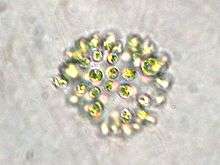Microcystis
| Microcystis | |
|---|---|
 | |
| Microcystis aeruginosa | |
| Scientific classification | |
| Kingdom: | Bacteria |
| Subkingdom: | Eubacteria |
| Phylum: | Cyanobacteria |
| Class: | Cyanophyceae |
| Order: | Chroococcales |
| Family: | Microcystaceae |
| Genus: | Microcystis Kützing, 1833 |
| species | |
|
Many (see below) | |
Microcystis is a genus of freshwater cyanobacteria which includes the harmful algal bloom Microcystis aeruginosa. The cyanobacteria can produce neurotoxins and hepatotoxins, such as microcystin and cyanopeptolin.
Etymology
The genus Microcystis derives from the Greek[1] mikros ("small") + kystis ("bladder")
Physical characteristics
As the etymological derivation implies, Microcystis is characterized by small cells (a few micrometers in diameter), possessing gas filled vesicles (also lacking individual sheaths).[1] The cells are usually organized into colonies (macroscopic aggregations of which are visible with the naked eye) that begin in a spherical shape, losing coherence to become perforated or irregularly shaped over time. These colonies are bound by a thick mucilage composed of complex polysaccharide compounds, including xylose, mannose, glucose, fucose, galactose, rhamnose, among other compounds.[2]
The coloration of the protoplast is a light blue-green, appearing dark or brown due to optical effects of gas-filled vesicles; this can be useful as a distinguishing characteristic when using light microscopy.
Ecology

Microcystis is capable of producing large surface blooms through a combination of rapid division and buoyancy regulation by production of gas-filled vesicles. Their ability to regulate buoyancy is key to their dominance of eutrophic waters, by optimally positioning themselves within the photic zone in a stable water column.
Because they can form large surface blooms, they are capable of out-competing other phytoplankton by essentially monopolizing light in the photic zone.
Microcystis is capable of strong uptake of phosphate and nitrogen; they are believed to strongly influence nitrogen to phosphorus ratios ("N:P ratio").[3]
Health risks
Cyanobacteria can produce neurotoxins and hepatotoxins, such as microcystin and cyanopeptolin.[4][5] Microcystis aeruginosa is a harmful algal bloom and can contaminate drinking water with microcystin.[6]
Species
Among Microcystis species are the following:[7]
- Microcystis aeruginosa
- Microcystis argentea
- Microcystis botrys
- Microcystis elongata
- Microcystis flos-aquae
- Microcystis holsatica
- Microcystis lutescens
- Microcystis marina
- Microcystis pallida
- Microcystis panniformis
- Microcystis salina
- Microcystis thermalis
- Microcystis viridis
- Microcystis wesenbergii
See also
References
- 1 2 "Cyanobacteria: Microcystis". The Silica Secchi Disk. Connecticut College: The SilicaSecchi Disk. Archived from the original on March 26, 2008. Retrieved 24 June 2011.
- ↑ Thomas Rohrlack, Manfred Henning and Johannes-Günter Kohl (1999). "Mechanisms of the inhibitory effect of the cyanobacterium Microcystis aeruginosa on Daphnia galeata's ingestion rate". Journal of Plankton Research. 73: 980–984. doi:10.1021/np900818c.
- ↑ Xie, Liqiang; Xie, Ping; Li, Sixin; Tang, Huijuan; Liu, Hong (2003). "The low TN:TP ratio, a cause or a result of Microcystis blooms?". Water Research. 37 (9): 2073–2080. doi:10.1016/S0043-1354(02)00532-8.
- ↑ "On the Evolution of Nonribosomal Peptide Synthetase Gene Clusters in Cyanobacteria". University of Oslo. 2007.
- ↑ Karl Gademann, Cyril Portmann, Judith F. Blom, Michael Zeder and Friedrich Jüttner (2010). "Multiple Toxin Production in the Cyanobacterium Microcystis: Isolation of the Toxic Protease Inhibitor Cyanopeptolin 1020". J. Nat. Prod. 73: 980–984. doi:10.1021/np900818c.
- ↑ Oberholster, PJ. "Microcystis aeruginosa: source of toxic microcystins in drinking water". African Journal of Biotechnology March 2004 Volume 3 pp 159-168. Retrieved August 4, 2014.
- ↑ "Taxonomy Browser Genus: Microcystis". Taxonomy Browser Genus: Microcystis. AlgaeBase. Retrieved 24 June 2011.